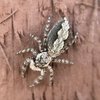Nicole C G
Arachnoangel
- Joined
- Jun 23, 2021
- Messages
- 882
With summer here/almost here, jumping spiders are everywhere. And with the increase of Jumping spiders, the numbers of people seeking jumper identification increases, naturally. So here is a guide on how to take proper photos with the highest chance of being able to be identified.
Before we talk about photos though, there are other things just as important. Location is very important to include. Where you found it too. If you are able to measure it, or even get a rough idea of the size, include that too.
An example of an informative description would be:
“Hello! I was walking at the park when I saw this little jumping spider hoping on some sunny rocks. I was wondering if anyone knows what species it could be. It was about 5mm. It was found in Denton County, Texas (USA). “
As used in the example, city/county is best when it comes to location. Even within one state there can be species that live on one side of the state but not the other. So be as specific as you feel comfortable.
Now onto photos.
First, make sure your photos are clear/mostly clear. You want to be able to see the patterns and shape of the spider. Usually a phone camera is enough. If it’s a smaller spider, use a magnifying glass or macro lens. Make sure there is sufficient lighting to see the patterns properly.
Usually for identifying the species, we will need a photo of the top (dorsal), a photo of the side, and a photo of the face. Any other angles are appreciated. If you are wanting to identify the gender/age of the spider as well, a photo of the underside (ventral) is needed. It can occasionally help with identifying species too. When photographing the underside, take the picture with flash on. This can help because the light will reflect off of the epigynum if it’s an adult female.




-Great angles for ID.

-(different spider than the last one) flash on, reflecting on epigynum making it more visible, meaning it’s an adult female.
These are good places to start. And of course, sometimes less photos or more photos are required. For instance, with only one photo, I can identify this as being an adult male Naphrys pulex.

And you don’t need to have the greatest photos. These are identifiable too:



And if you see jumpers breeding, it’s simple to determine age and gender. The one on the top is always an adult male, and the one on the bottom is always an adult female.

Before we talk about photos though, there are other things just as important. Location is very important to include. Where you found it too. If you are able to measure it, or even get a rough idea of the size, include that too.
An example of an informative description would be:
“Hello! I was walking at the park when I saw this little jumping spider hoping on some sunny rocks. I was wondering if anyone knows what species it could be. It was about 5mm. It was found in Denton County, Texas (USA). “
As used in the example, city/county is best when it comes to location. Even within one state there can be species that live on one side of the state but not the other. So be as specific as you feel comfortable.
Now onto photos.
First, make sure your photos are clear/mostly clear. You want to be able to see the patterns and shape of the spider. Usually a phone camera is enough. If it’s a smaller spider, use a magnifying glass or macro lens. Make sure there is sufficient lighting to see the patterns properly.
Usually for identifying the species, we will need a photo of the top (dorsal), a photo of the side, and a photo of the face. Any other angles are appreciated. If you are wanting to identify the gender/age of the spider as well, a photo of the underside (ventral) is needed. It can occasionally help with identifying species too. When photographing the underside, take the picture with flash on. This can help because the light will reflect off of the epigynum if it’s an adult female.




-Great angles for ID.

-(different spider than the last one) flash on, reflecting on epigynum making it more visible, meaning it’s an adult female.
These are good places to start. And of course, sometimes less photos or more photos are required. For instance, with only one photo, I can identify this as being an adult male Naphrys pulex.

And you don’t need to have the greatest photos. These are identifiable too:



And if you see jumpers breeding, it’s simple to determine age and gender. The one on the top is always an adult male, and the one on the bottom is always an adult female.















